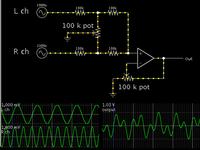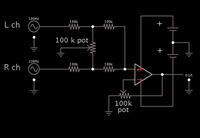rajaram04
Advanced Member level 3
Hello sir
Sometimes in live shows we need to play stereo out instruments with a mono line as we don't always get such hifi PA system so we have to manage with them . . . . If i connect my left channel to output i am unable to hear right one at out end or vice verca , so i need a proper ciruit diagram for stereo to mono convertion with simple available components no matter its transistorized or with ICs . . please help . . thanks
Sometimes in live shows we need to play stereo out instruments with a mono line as we don't always get such hifi PA system so we have to manage with them . . . . If i connect my left channel to output i am unable to hear right one at out end or vice verca , so i need a proper ciruit diagram for stereo to mono convertion with simple available components no matter its transistorized or with ICs . . please help . . thanks

